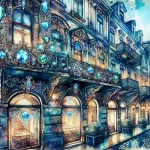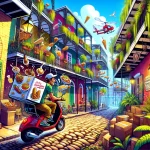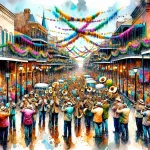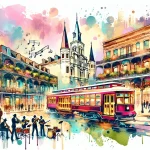Exuding a captivating blend of history, culture, and sensory enchantment, the French Quarter stands as New Orleans’ most iconic neighborhood. This 78-square-block area, also known as Vieux Carré, has been the beating heart of the city since its establishment in 1718. With colorful buildings adorned with ornate ironwork balconies and lively streets, the French Quarter offers an unparalleled experience for visitors and locals alike.
In This Article
TL;DR
- Immerse yourself in the rich history, architecture, cuisine, art, music, and festivals that define the French Quarter.
- Discover unique shopping opportunities, from antique stores to voodoo shops, and a vibrant nightlife scene.
- Plan your visit with insights on the best times to go, accommodations, and navigating the area.
Historical Significance of the French Quarter
The French Quarter’s legacy dates back to the early 18th century when the French established New Orleans. The neighborhood’s layout, featuring grid-like streets and a central square (now Jackson Square), was designed by French engineer Adrien de Pauger. Throughout its history, the French Quarter has been shaped by French, Spanish, and African influences, creating a distinctive blend of architectural styles and cultural traditions.
One of the most significant historical landmarks in the French Quarter is St. Louis Cathedral, the oldest continuously active cathedral in the United States. The cathedral, which faces Jackson Square, has been a focal point of the city’s religious and cultural life since its construction in the late 18th century.
Architectural Marvels in the French Quarter
The French Quarter is revered for its distinctive architecture, which seamlessly blends French, Spanish, and Creole styles. The iconic cast-iron balconies, adorned with intricate designs and vibrant colors, are a hallmark of the neighborhood’s architecture. Many of these balconies were added to existing buildings in the mid-19th century, during a period of economic prosperity in New Orleans.
Notable buildings in the French Quarter include the Cabildo, a former government building that now houses the Louisiana State Museum, and the Pontalba Buildings, which are considered the oldest continuously rented apartment buildings in the United States.
Culinary Delights of the French Quarter
New Orleans is renowned for its unique and delectable cuisine, and the French Quarter is the perfect place to indulge in the city’s culinary offerings. Some of the most famous local dishes include gumbo, a savory stew made with seafood or meat and served over rice, and jambalaya, a rice dish featuring meat, seafood, and vegetables.
For a taste of classic New Orleans cuisine, visit renowned restaurants like Brennan’s (417 Royal St, New Orleans, LA 70130, (504) 525-9711), known for its decadent breakfast and brunch offerings, or Galatoire’s (209 Bourbon St, New Orleans, LA 70130, (504) 525-2021), a fine-dining establishment that has been serving French-Creole cuisine since 1905.
No visit to the French Quarter is complete without trying the famous beignets at Café du Monde (800 Decatur St, New Orleans, LA 70116, (504) 525-4544). These square-shaped doughnuts, covered in powdered sugar, are a New Orleans institution and a must-try for any visitor.
Art and Music Scene
The French Quarter is a hub for art and music, with numerous galleries, street performers, and live music venues throughout the neighborhood. Royal Street is known for its art galleries, showcasing works by local and international artists. The French Quarter is also home to a thriving street art scene, with colorful murals and installations found throughout the neighborhood.
For live music, head to Preservation Hall (726 St Peter, New Orleans, LA 70116, (504) 522-2841), a historic venue that has been showcasing traditional New Orleans jazz since the 1960s. Other notable music venues include the Spotted Cat Music Club (623 Frenchmen St, New Orleans, LA 70116, (504) 943-3887) and d.b.a. (618 Frenchmen St, New Orleans, LA 70116, (504) 942-3731), both located just outside the French Quarter in the Marigny neighborhood.
Unique Shops and Markets
The French Quarter is home to a variety of unique shops and markets, offering everything from antiques and local art to voodoo supplies and Mardi Gras masks. The French Market (1008 N Peters St, New Orleans, LA 70116, (504) 636-6400), located on the edge of the French Quarter, is a historic open-air market featuring food vendors, artisans, and local produce.
For a one-of-a-kind shopping experience, visit the Marie Laveau House of Voodoo (739 Bourbon St, New Orleans, LA 70116, (504) 581-3751), which offers a wide selection of voodoo-related items, including candles, potions, and talismans. Another unique shop is Faulkner House Books (624 Pirates Alley, New Orleans, LA 70116, (504) 524-2940), located in the former home of writer William Faulkner and specializing in rare and used books.
Festivals and Events
The French Quarter is the epicenter of many of New Orleans’ famous festivals and events, including Mardi Gras and the French Quarter Festival. Mardi Gras, which takes place in February or March, is a multi-day celebration featuring parades, costumes, and street parties. The French Quarter Festival, held in April, is the largest free music festival in the United States, showcasing local music, food, and culture.
Other notable events include the Satchmo Summerfest, a celebration of the life and music of Louis Armstrong, and the Creole Tomato Festival, which honors the beloved local tomato variety.
Nightlife and Entertainment
The French Quarter is famous for its vibrant nightlife, with numerous bars, clubs, and live entertainment venues. Bourbon Street, the most well-known street in the French Quarter, is lined with bars and clubs offering live music, cocktails, and a lively atmosphere.
For a more laid-back experience, visit one of the French Quarter’s many historic bars, such as Lafitte’s Blacksmith Shop (941 Bourbon St, New Orleans, LA 70116, (504) 593-9761), which dates back to the 18th century and is believed to be the oldest structure used as a bar in the United States.
When enjoying the French Quarter’s nightlife, it’s essential to practice safety and be aware of your surroundings. Stick to well-lit and populated areas, avoid carrying large amounts of cash, and always keep an eye on your drinks.
Practical Tips for Visitors
The best times to visit the French Quarter are during the spring (March to May) and fall (October to November) when the weather is mild and there are fewer crowds. During the summer months, temperatures can be hot and humid, and the streets can be crowded with tourists.
To get around the French Quarter, walking is the best option, as many of the streets are narrow and parking can be difficult to find. For longer distances, consider using the city’s streetcar system or ride-sharing services like Uber or Lyft.
When choosing accommodations in the French Quarter, there are numerous options ranging from historic hotels to charming bed and breakfasts. Some notable hotels include the Hotel Monteleone (214 Royal St, New Orleans, LA 70130, (504) 523-3341), which has been a French Quarter landmark since 1886, and the Bourbon Orleans Hotel (717 Orleans St, New Orleans, LA 70116, (504) 523-2222), which offers elegant rooms and a prime location near Jackson Square.
The French Quarter is a must-visit destination for anyone traveling to New Orleans. With its rich history, stunning architecture, delicious cuisine, and vibrant culture, the French Quarter offers an unforgettable experience that captures the essence of the Crescent City.






